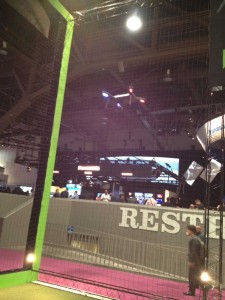
While this is a slight exaggeration, drones – quadcopters, hexcopters, octocopters, dodecacopters (with 12 rotors and props), gimbals, gimbal control units and flight demos – were in dozens of booths and in all three halls at NAB 2015 this week in Las Vegas. Unmanned aerial vehicles (UAV) were this year’s 4K. There were so many drone manufacturers, system integrators and resellers on the show floor that it would be difficult to do more than cover the highlights.
There were net cages sprinkled throughout the convention center to keep the drone demos from getting out of hand – or out of line of sight. The largest flight cage was at the Aerial Robotics and Drone Pavilion on the upper level of South Hall. This was a netted 30-foot cube in front of a seating area for presentations. While I was there, a speaker from Canon was talking about ways to create and use aerial footage.
The myriad drones on display could be divided into three categories: small RC helicopters capable of flying a GoPro; larger so-called “heavy lifters” that can lift a DSLR and, in some cases, a RED Epic; and professional cinema drones that can hoist fully outfitted Hollywood-standard cameras, such as the new ARRI Alexa Mini or, in one case, even the Phantom Flex4K (made by Vision Research).
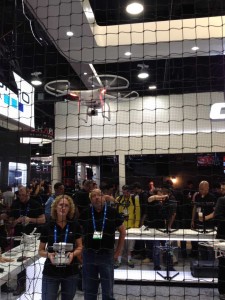
Any consumer looking for a small RC helicopter to fly their GoPro camera could find dozens of makes and models that can be operated by a single person, acting as both pilot and camera operator.
The Phantom 3 quadcopter from DJI had its own netted cage and is designed to carry a GoPro. It costs $999. GoPro cameras could be viewed next door to DJI at one of the more well-attended booths. It attracted large crowds for its presentations and giveaways and had VR headsets that a lucky few could demo.
The 3D Robotics Solo drone is also designed to hold a GoPro and can do two neat things. Its Cable Cam feature takes advantage of GPS stabilization to fly between two set points. It also has a Selfie option that locks on a focal point – such as the user on the ground – as it rises, giving wonderful bird’s-eye views. 3DR had one of the larger drone cages at its booth to show off the Solo. With the gimbal and camera on board it has a flight time of 20 minutes. The Solo and controller retail for $999. The gimbal is an additional $399.
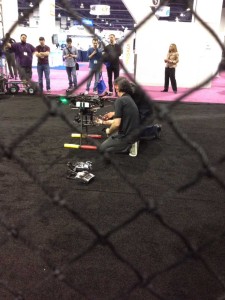
These UAVs have sufficient lift and battery power to carry a RED Epic (weighing five lbs., without lens, which adds considerably to the weight), the camera that many of them seemed to be aiming to carry.
DJI introduced its S1000+ octocopter, which can carry some DSLR cameras (e.g. the roughly five-lb. Canon EOS 5D Mark III) and retails ready to fly at $4,035-6,865.
Freefly brought the Alta, capable of carrying a loaded camera (with lens and battery) weighing up to 10 lbs. With a RED Epic on board, the Alta can stay aloft for eight minutes. In addition to the traditional underslung mount, a camera can be mounted on top of the Alta, perhaps to capture images from below of someone climbing a rock wall. Freefly is also the maker of the Movi series of gimbals, used by many other mid-range drones to carry their payloads.
Turbo Ace is a system integrator that provides both gimbals and drones. Its Infinity 9 octocopter has a flight time of up to 15 minutes with the RED Epic. It uses a DJI flight controller, has a gimbal with retractable legs and costs $12,000-20,000.
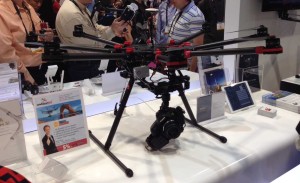
Aeronavics had both a quadrocopter and a coaxial octocopter on view. The gimbal used on its SkyJib drones is manufactured by Gremsy, which had a number of lightweight gimbals for aerial cinematography on hand. The Tornado H920 from Yuneec is designed for the Panasonic Lumix GH4.
Quadrocopter had a FreeFly Alta octocopter on display attached to a Movi gimbal. A small wedge is available that connects the camera’s focus and zoom controls to a gimbal control unit (GCU) operated on the ground by the camera operator. The drone alone costs $8,500, with gimbal, controller and camera equipment extra.
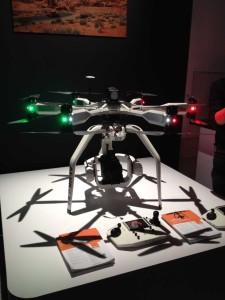
These are the true heavy lifters, capable of carrying production-quality cameras for film and broadcast. Such a UAV, if it’s going to have the strength, image-capture stability and safety to handle cameras worth upwards of $50,000, needs a sturdy frame and a reliable way for the pilot and camera operator to control the flight – especially landing – as well as the camera’s movements. We saw only two examples of such drones at this year’s show.
The xFold Dragon can carry a fully rigged ARRI Alexa with lens and has been used on feature films. It retails starting at $27,150 for the ready-to-fly version.
Intuitive Aerial brought its Aerigon drone, which could be seen at both the Canon and RED booths. This professional cinema drone has a payload of more than 15 lbs. of camera and lens, meaning that it can lift the Phantom Flex4K, ARRI Alexa and other cameras used for feature films. Intuitive Aerial introduced its GCU that allows precision control of the IA gimbal, camera and lens functions, such as focus, iris and zoom. The price for the Aerigon starts at $41,000.
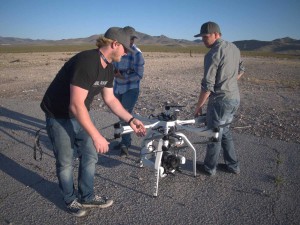
As anticipated prior to the show, NAB had something for every drone enthusiast. As the FAA continues to review its drone regulations, it appears that UAVs for recreational use, broadcast and even feature films are here to stay.
Courtesy James Sykes, Aerial Pro Films





